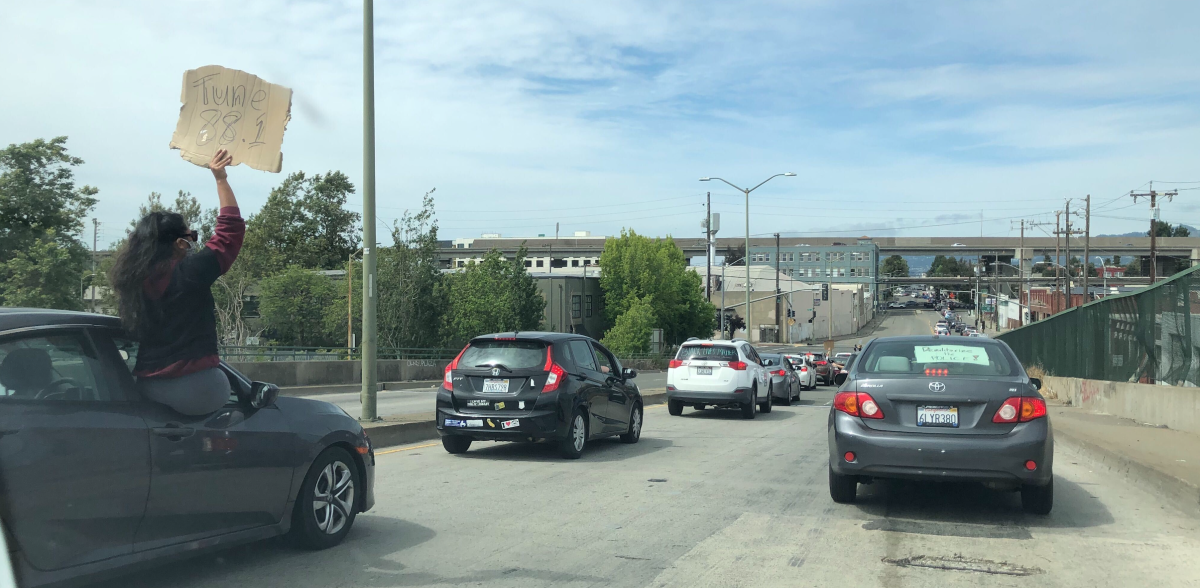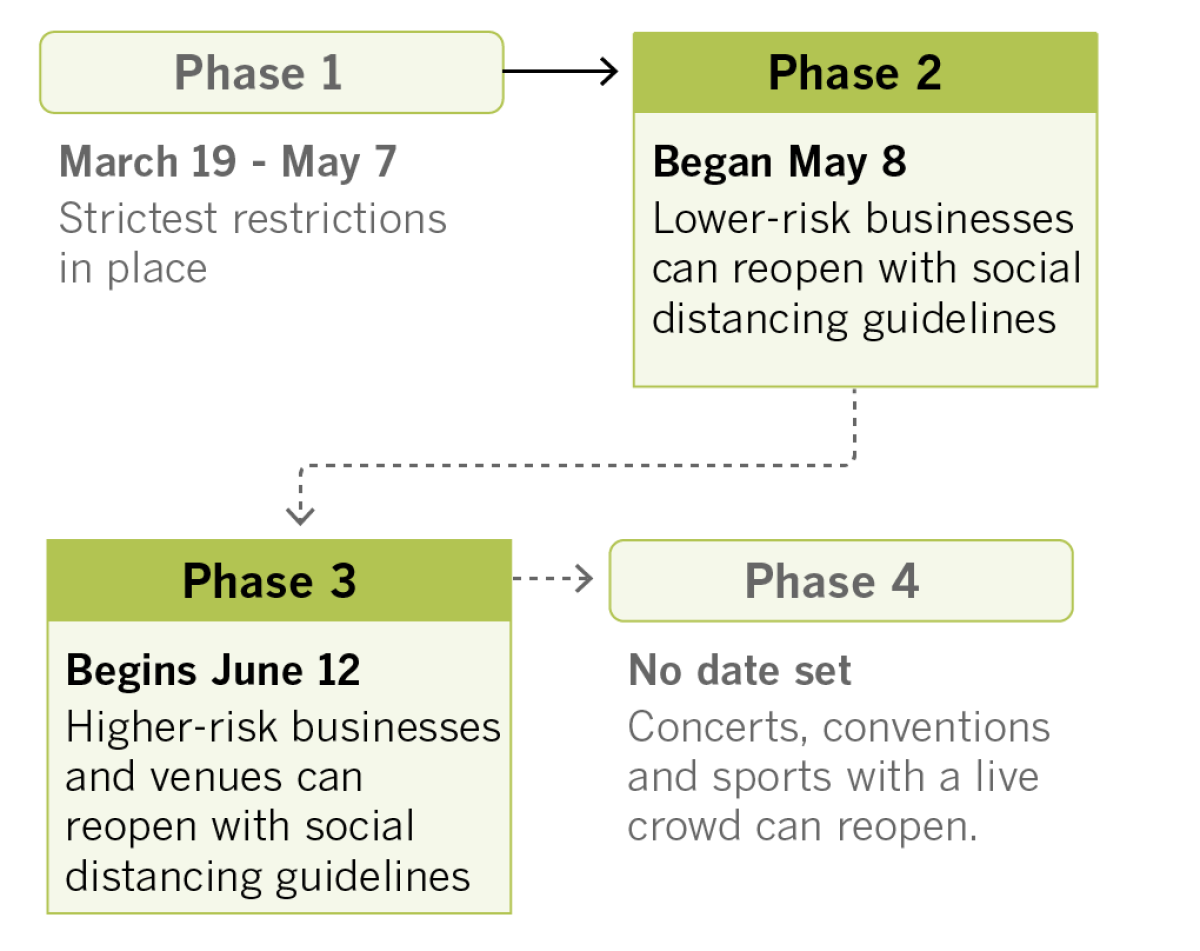Coronavirus Today: Protesting and COVID-19
Good evening. Iâm Diya Chacko, and itâs Monday, June 1. Hereâs whatâs happening with the coronavirus in California and beyond.
âFrom a human perspective, as a person, we need this. Period. From a public health perspective, Iâm worried.â
Thatâs what one Cal State Long Beach epidemiology lecturer had to say about the protests sweeping California and the nation over the weekend, and continuing today. With the killing of George Floyd, an unarmed black man in police custody in Minneapolis, long-standing anger over police violence against black people has collided with the newer threat of the COVID-19 pandemic.
Data show that the coronavirus has been especially devastating to black communities, with African Americans suffering a disproportionate share of COVID-19 deaths. âWhen I report each week that we have seen elevated numbers of black deaths in this county due to COVID-19, I am reporting on the consequences of these long-standing inequities,â said Los Angeles County Public Health Director Barbara Ferrer.
The situation has left protesters facing a dilemma: How do you balance the desire to exercise the constitutional right to assemble against the risk of contracting or spreading a virus that has killed thousands? Political protests of up to 100 people are one of two types of mass gatherings allowed under the stateâs updated shelter-in-place order (the other is in-person religious gatherings). Theyâre also permitted under L.A. Countyâs latest guidance. But itâs still unclear how such gatherings could affect the spread of COVID-19.
Many of those who marched in the Los Angeles area said they were willing to face that risk. Over the weekend, most protesters wore masks, and some passed out hand sanitizer. âI donât think I was the only person debating, âIs this safe?â But this is bigger than us,â a protester said.
In the Bay Area, a caravan of thousands of vehicles drove through downtown Oakland for more than three hours on Sunday in order to demonstrate without violating social-distancing guidelines. âWeâre in the middle of a pandemic that is inequitably and disproportionately impacting black and brown bodies,â said the organizer. âSo itâs important for us to have different ways to protest.â
The California Department of Public Health has released guidelines for protesting during the pandemic. Read more on this in the âYour questions answeredâ section of this newsletter.

By the numbers
California cases and deaths as of 5:30 p.m. PDT Monday:
Track the latest numbers and how they break down in California with our graphics.

See which counties are reopening with our tracker.
Across California
Several L.A. County coronavirus testing sites were closed Monday in the wake of the protests, with Health Services Director Christina Ghaly saying they were affecting public safety. Testing at Dodger Stadium and Kedren Community Health Center continued, while other locations were closed. Officials say they expect to reopen all sites on Tuesday.
Although many of Californiaâs rugged northern counties have largely been spared from COVID-19, their remoteness hasnât inoculated them from the economic fallout of the shutdown. Many businesses that rely on tourists are wondering if they will last through the summer. âWe make 70% of our revenue in three months,â said the owner of a campground in Nevada City. âAnd we canât do that right now.â
Even Santa Cruz County, which houses tech and other businesses, depends greatly on seasonal tourism and the revenue generated by the 19,000 students and hundreds of faculty and employees at UC Santa Cruz. That campus is now closed, and city and county have been urging visitors they once welcomed to stay away, at least for now. âI understand why people are itching to reopen, and the amount thatâs at stake in terms of the economy and jobs and peopleâs livelihoods,â said a local bookstore owner. âBut Iâm going to be completely driven by science.â
Although state health officials issued recommendations for universal COVID-19 testing in skilled nursing facilities, critics say that the state has merely laid out guidelines that shift responsibility onto counties and nursing homes to actually perform the tests. The likely result: Scores of individual, uncoordinated plans with no clear rules for how programs will work, what is required and who will pay. âWe just have a lot of unanswered logistical questions,â said the director of emergency preparedness for the California Assn. of Heath Facilities.
Resources
â For general safety, wash your hands for at least 20 seconds (hereâs a super-fun how-to video). Stop touching your face, and keep your phone clean. Practice social distancing, maintaining a six-foot radius of personal space in public. And wear a mask if you leave home. Hereâs how to do it right.
â Watch for symptoms including fever, cough, shortness of breath, chills, repeated shaking with chills, muscle pain, headache, sore throat and loss of taste or smell. If youâre worried you might be infected, call your doctor or urgent care clinic before going.
â Hereâs how to care for someone with COVID-19, from monitoring their symptoms to preventing the virusâ spread.
â If your job has been affected by the coronavirus pandemic, hereâs how to file for unemployment.
â Here are some free resources for restaurant workers and entertainment industry professionals having trouble making ends meet.
â Advice for helping kids navigate pandemic life includes being honest about uncertainties, acknowledging their feelings and sticking to a routine. Hereâs guidance from the CDC.
â In need of mental health services? Here are resources for coping during the crisis from the CDC and the L.A. County Department of Public Health. L.A. County residents can also call (800) 854-7771 or text âLAâ to 741741.
Around the nation and the world
From engineers to cancer researchers, scientists with no experience in virology are putting their diverse talents to use to address the COVID-19 pandemic. Theyâre working to improve the design of coronavirus tests, studying new treatments and discovering methods to disinfect N95 masks for safe reuse. For many, the work provides a way to make a difference now that the pandemic has shut down their other research projects. âIt is a consolation,â said a stem cell biologist at UCLA. âIt would be awful to be sitting, waiting to do something useful.â
SpaceXâs Crew Dragon astronaut capsule successfully docked with the International Space Station on Sunday, a little less than 19 hours after its historic launch from Florida. To prepare for the launch during the pandemic, NASA had to evaluate the astronautsâ remaining training sessions and decide which could be held remotely, such as learning how to use the space stationâs kitchen.
What is this economic crisis in which we find ourselves? A recession? A depression? Something new and entirely different? The Times asked a range of economists to consider that question and propose a single policy or action government officials could embrace that would make a difference. Their answers range from the passage of paycheck relief programs to keep workers at their jobs to an extreme ramp-up of antibody testing to aid the reopening of businesses.
Your questions answered
Todayâs question comes from readers who want to know: How can I protest while reducing the risk of transmitting the coronavirus? The California Department of Public Health has a few guidelines.
Even during the pandemic, you have the right to engage in protests under the protection of the 1st Amendment.
However, in-person protests do run the risk of spreading the coronavirus. Even with adherence to physical distancing, âsuch gatherings may result in increased rates of infection, hospitalization and death, especially among more vulnerable populations,â according to the agencyâs COVID-19 website.
Protesters should wear face coverings and try to maintain six feet of social distancing as much as possible during demonstrations, especially if chanting. Itâs also advisable to carry hand sanitizer and try to avoid touching surfaces that others may also touch. After participating, consider self-quarantining for the recommended period of 14 days, particularly if youâre regularly in close contact with vulnerable people.
DPH also suggests you consider whether you and other participants can safely protest from within your cars, as thousands did in the Bay Area on Sunday. In-car protests are not considered to be gatherings, as long as participants stay in their cars and otherwise remain apart from individuals who are not part of their households.
Got a question? Our reporters covering the coronavirus outbreak want to hear from you. Email us your questions, and weâll do our best to answer them. You can find more answers in our Frequently Asked Questions roundup and in our morning briefing.
For the most up-to-date coronavirus coverage from The Times, visit our homepage and our Health section, listen to our âCoronavirus in Californiaâ podcast and follow us on Twitter and on Instagram.





